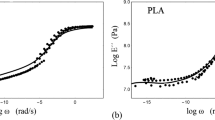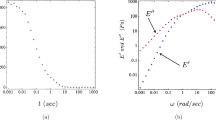Abstract
Starting from an analysis of the rheological behavior of the complex modulus predicted by the Cole-Cole formalism, a generalized Cole-Cole ansatz is suggested in order to overcome the related difficulties. The corresponding rheological constitutive equation with fractional derivatives belonging to the generalized Cole-Cole respondance is stated and the characteristic material functions of the linear viscoelasticity theory (like the dynamic modulus and compliance, the relaxation and ratardation functions, the spectra, etc.) are derived. Model predictions of these functions will be compared with experimental results from dynamical measurements and creep data on different polymer systems which show cooperative phenomena (polymeric glasses and gelling systems). One can see that the modified ansatz fits the data very well, in spite of its relative simplicity.
Similar content being viewed by others
References
Berger L (1988) Untersuchung zum Rheologischen Verbalten von Polybutadienen mit Bimodaler Molmassenverteilung. Ph. D. Thesis, Zürich
Batman H (1955) Higher transcendental functions, vol III. McGraw-Hill, New York Toronto London
Baumgärtel M, Winter HH (1989) Determination of discrete relaxation and retardation time spectra from dynamic mechanical data. Rheol Acta 28:511–519
Cole KS, Cole RH (1941) J Chem Phys 9:341
Douglas JF, Hubbard JB (1991) Semiempirical theory of relaxation: concentrated polymer solution dynamics. Macromolecules 24:3163–3177
Friedrich C (1991a) Relaxation and retardation functions of the Maxwell model with fractional derivatives. Rheol Acta 30:151–158
Friedrich C (1991b) Relaxation functions of rheological constitutive equations with fractional derivatives: thermodynamical constraints. In: Casas-Vaszquez J, Jou D (eds) Lecture notes in physics No. 381. Springer, Berlin Heidelberg New York, pp 321–330
Havriliak S, Negami S (1967) A complex plane representation of dielectric and mechanical relaxation processes in some polymers. Polymer 8:161–210
Hilger C, Stadler R, de Lucca Freitas L (1990) Multiphase thermoplastic elastomers by combination of covalent and association chain structures. Polymer 31:818–823
de Lucca Freitas L, Stadler R (1987) Macromolecules 20:2478
McKenna GR (1989) Glass formation and glassy behavior. In: Allen G, Bevington JC (eds) Comprehensive polymer science, vol 2. Pergamon Press, Oxford, pp 311–362
Nonnenmacher TF (1991) Fractional relaxation equations for viscoelasticity and related phenomena. In: CasasVaszquez J, Jou D (eds) Lecture notes in physics No. 381. Springer, Berlin Heidelberg New York, pp 309–320
Oldham KB, Spanier J (1974) The fractional calculus. Academic Press, New York London
Read BE, Dean GD, Tomlins PE (1988) Effects of physical ageing on creep in polypropylene. Polymer 29:2159–2169
Tobolsky AV, Catsiff E (1956) Elastoviscous properties of polyisobutylene (and other amorphous polymers) from stress-relaxation studies. IX A summary of results. J Polymer Sci XIX:111–121
Tschoegl NW (1989) The phenomenological theory of linear viscoelastic behavior-an introduction. Springer, Berlin Heidelberg New York
Williams G (1989) Dielectric properties. In: Allen G, Bevington JC (eds) Comprehensive polymer science, vol 2. Pergamon Press, Oxford, pp 601–632
Wytack L (1979) Padé approximation and its application. Springer, Berlin Heidelberg New York
Author information
Authors and Affiliations
Rights and permissions
About this article
Cite this article
Friedrich, C., Braun, H. Generalized Cole-Cole behavior and its rheological relevance. Rheola Acta 31, 309–322 (1992). https://doi.org/10.1007/BF00418328
Received:
Revised:
Issue Date:
DOI: https://doi.org/10.1007/BF00418328




